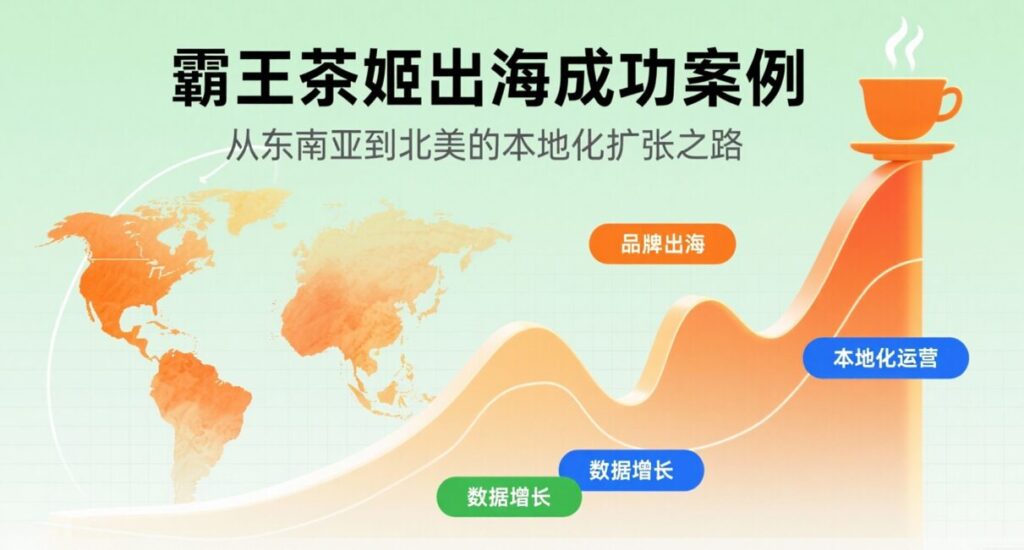As a globalized model of a rapidly expanding tea beverage brand, Ba Wang Cha Ji demonstrates a clear market expansion timeline in its international strategy, offering a typical reference case for new consumer brands venturing overseas. The brand’s global trajectory begins in Southeast Asia and gradually expands into high-potential markets such as North America. The entry into the Philippines holds strategic significance—it marks the seventh international market and signifies a deeper regional consolidation in Southeast Asia. In Manila, the brand simultaneously launched stores in core commercial districts, achieving rapid market entry through precise site selection and localized operations, providing critical practical insights for optimizing future global strategies.

Key Factors Behind Successful Overseas Expansion
Localized Operational Strategy: Adapting to Market Needs
The core of Ba Wang Cha Ji’s successful overseas expansion lies in its dual-driven localized operational strategy centered on spatial scenarios and user experience. In terms of spatial scenarios, the brand achieves high-value customer reach by precisely targeting core commercial districts. Leveraging natural foot traffic and the consumption level of these areas, the brand establishes the “first touchpoint” for brand awareness. This site selection logic has been validated across multiple markets—from Southeast Asia to North America—where the traffic advantages of core commercial districts provide strong initial exposure for the brand.
At the user experience level, localized marketing activities have become a key driver for member conversion. By integrating local cultural elements into grand opening events, the brand rapidly accumulates users. Member growth data across different markets indicate that interaction formats tailored to local consumer preferences can effectively lower decision-making thresholds and shorten the conversion path from trial consumption to member retention.
However, not all brands possess the resources to implement such localized strategies. SMEs often face challenges such as low efficiency in content localization and imprecise channel matching during cross-cultural expansion. To address these issues, a technology-enabled approach can be adopted—for example, leveraging AI-powered multilingual content generation and channel-matching tools. These tools optimize translation automation, adapt cultural elements, and utilize social media algorithms to reduce cross-cultural communication costs, thereby achieving precise audience targeting and transforming successful practices into reusable, scalable solutions.
Building a Professional Team: Strategic Empowerment Through Cross-Industry Talent
To break through market barriers in North America, Ba Wang Cha Ji has built a professional and localized team through a core talent strategy, appointing senior executives with extensive experience in food service, brand marketing, and commercial development to oversee regional operations. These executives’ industry expertise enables targeted solutions for market-specific challenges: brand management experience strengthens brand awareness, while chain development experience accelerates store expansion efficiency.
This combination of “core talent + industry experience” not only addresses specific market needs but also serves as a replicable model for new consumer brands to overcome cultural barriers and achieve scalable profitability. Compared to the common challenge SMEs face in lacking overseas professional teams, this approach highlights the critical role of talent strategy in breaking through regional market barriers.
Data-Driven Decision-Making: A Closed Loop for Performance Growth and Operational Optimization
Ba Wang Cha Ji’s overseas expansion is consistently driven by data, forming a complete closed-loop system from data analysis to strategy adjustment and growth validation. This system not only enhances operational efficiency with precision but also serves as a key engine for rapid adaptation and iteration across different markets.
Through data-driven decisions such as membership system optimization, product portfolio adjustments, and marketing budget allocation, the brand tailors its operational strategies to each market’s characteristics. The “data feedback—rapid iteration” lean operation model significantly reduces trial-and-error costs, offering SMEs a replicable reference path—replacing large-scale investments with incremental testing, enabling rapid market opportunity capture through精细化 operations while managing risks.

Insights for SMEs Going Global
SMEs often encounter three core challenges when expanding overseas: difficulties in local market entry, lack of professional teams, and cost control pressures. Ba Wang Cha Ji’s global practices provide replicable reference models to address these pain points. By combining lightweight tools with flexible strategies, SMEs can achieve efficient overseas expansion even with limited resources.
In terms of localization, SMEs should prioritize deep penetration into core target markets to avoid resource dispersion; leverage intelligent tools to streamline content conversion processes and achieve efficient localized content delivery under resource constraints. Regarding team building, adopt a lightweight model combining a core team with external collaboration—obtaining market strategy support through consulting services or establishing flexible partnerships with local agencies. For cost control, test with small budgets, validate business model feasibility through data, and gradually scale investments after confirming market potential, avoiding resource waste caused by blind expansion.
Overall, SMEs do not need to replicate large enterprises’ capital-intensive models. By focusing on core markets, adopting flexible collaborations, and implementing data-driven lean strategies, combined with intelligent tools to enhance operational efficiency, they can achieve global breakthroughs even with limited resources.
Conclusion and Outlook
Ba Wang Cha Ji’s overseas journey reveals the core logic for new consumer brands to transcend geographical boundaries: adapting localization strategies to target market cultural preferences, building operational moats through professional capabilities, and optimizing decision-making with digital tools. The synergy of these three elements supports its global expansion. This model not only validates the global potential of the tea beverage category but also offers a replicable methodology framework for new consumer brands going overseas.
From an industry perspective, the overseas expansion of new consumer brands is evolving—from entering culturally similar markets toward higher-potential ones, from simple product exports to brand philosophy exports, and from price competition to user experience competition. This evolution indicates that the global consumer market is entering a window period of “brand value reengineering,” where brands with cultural adaptability and refined operational capabilities will gain greater growth opportunities.
For SMEs, leveraging digital tools and third-party service ecosystems can significantly lower the barriers to overseas expansion. The key lies in moving beyond a product-centric mindset and shifting toward user asset management—precisely capturing target market demand differences, transforming product functions into cultural symbols, and ultimately achieving the transition from short-term popularity to long-term market establishment.